Analysis of Fire Suppression Systems in SciTech Building
VerifiedAdded on 2023/03/17
|28
|4790
|54
Report
AI Summary
This report analyzes the fire suppression and detection systems implemented in the SciTech building at Queensland University of Technology. The report details the hydraulic components, including water sources, valves, fire pumps, fire hydrants, fire hose reels, and sprinkler systems, and their functionalities. It also covers the electrical fire detection systems and their components. The analysis includes a justification of the system design, adherence to Australian standards, and an evaluation of the strengths and weaknesses of the implemented fire safety measures. The report provides a comprehensive overview of the integrated fire safety measures within the building, offering insights into design, functionality, and compliance with relevant standards.

Running head: BUIDING SERVICES 0
BUILDING SERVICES
Name of Student
Institution Affiliation
0
BUILDING SERVICES
Name of Student
Institution Affiliation
0
Paraphrase This Document
Need a fresh take? Get an instant paraphrase of this document with our AI Paraphraser

BUILDING SERVICES 1
5.0 Fire Services
5.1 Fire Suppression (Hydraulics)
5.1.1 System purpose and function
A system of fire suppression is a vital installation in any building that carries out the important
duty of stopping the wide spread breakouts of fire. In the past and recent periods, fire breakouts
have been a major occurrence in most buildings and it is therefore important to put in place
several strategies that will ensure similar incidents are avoided in the near future. Fire breakouts
make up one of the most dangerous and threatening incidents both to the safety of the occupants
of the buildings as well as to the general damage to the building facilities and the environment at
large. The most suggested and equally effective means of taking care of the fire incidences is
through the adoption of a fire suppression system in buildings (Henderson, 2013).
The whole system represents an engineered collection of components that are developed in order
to assist in extinguishing any form of accidental fire in buildings. The design of a fire
extinguisher involves a system of fire alarm that is linked to a fire extinguisher, hole reel, fire
hydrants, extinguisher as well as sprinkler system. Most fire suppression systems are made up of
a system of fire detection and a mechanism of signalling in order to alert the nearby workers of
the occurrence of a fire breakout. The alarm mechanism is able to detect smoke or fire and
subsequently signal the fire extinguisher to put the fire out.
Categorisation of a fire suppression system comprises 3 vital sections i.e. electrical fire detection,
hydraulic suppression services and mechanical fire control.
5.0 Fire Services
5.1 Fire Suppression (Hydraulics)
5.1.1 System purpose and function
A system of fire suppression is a vital installation in any building that carries out the important
duty of stopping the wide spread breakouts of fire. In the past and recent periods, fire breakouts
have been a major occurrence in most buildings and it is therefore important to put in place
several strategies that will ensure similar incidents are avoided in the near future. Fire breakouts
make up one of the most dangerous and threatening incidents both to the safety of the occupants
of the buildings as well as to the general damage to the building facilities and the environment at
large. The most suggested and equally effective means of taking care of the fire incidences is
through the adoption of a fire suppression system in buildings (Henderson, 2013).
The whole system represents an engineered collection of components that are developed in order
to assist in extinguishing any form of accidental fire in buildings. The design of a fire
extinguisher involves a system of fire alarm that is linked to a fire extinguisher, hole reel, fire
hydrants, extinguisher as well as sprinkler system. Most fire suppression systems are made up of
a system of fire detection and a mechanism of signalling in order to alert the nearby workers of
the occurrence of a fire breakout. The alarm mechanism is able to detect smoke or fire and
subsequently signal the fire extinguisher to put the fire out.
Categorisation of a fire suppression system comprises 3 vital sections i.e. electrical fire detection,
hydraulic suppression services and mechanical fire control.
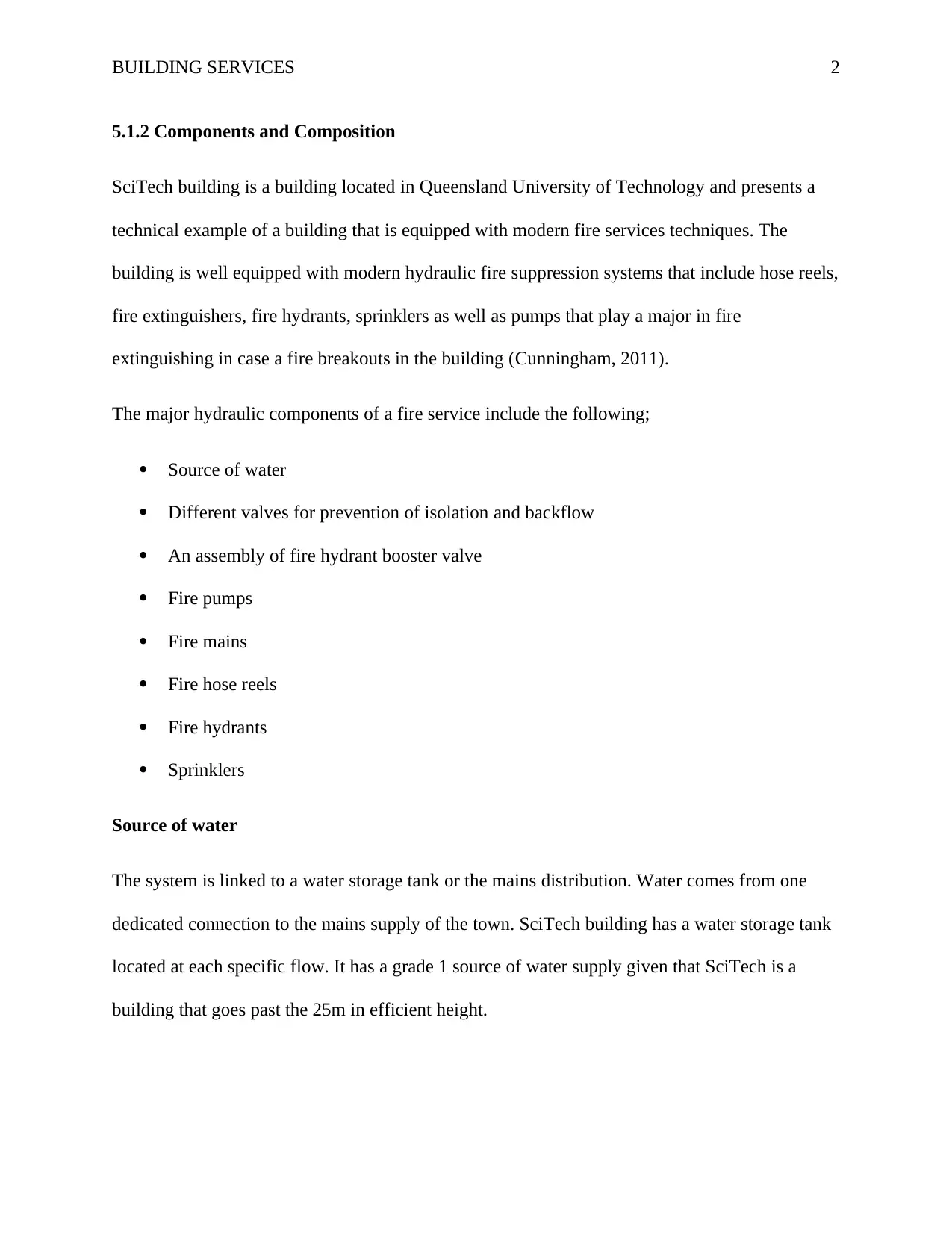
BUILDING SERVICES 2
5.1.2 Components and Composition
SciTech building is a building located in Queensland University of Technology and presents a
technical example of a building that is equipped with modern fire services techniques. The
building is well equipped with modern hydraulic fire suppression systems that include hose reels,
fire extinguishers, fire hydrants, sprinklers as well as pumps that play a major in fire
extinguishing in case a fire breakouts in the building (Cunningham, 2011).
The major hydraulic components of a fire service include the following;
Source of water
Different valves for prevention of isolation and backflow
An assembly of fire hydrant booster valve
Fire pumps
Fire mains
Fire hose reels
Fire hydrants
Sprinklers
Source of water
The system is linked to a water storage tank or the mains distribution. Water comes from one
dedicated connection to the mains supply of the town. SciTech building has a water storage tank
located at each specific flow. It has a grade 1 source of water supply given that SciTech is a
building that goes past the 25m in efficient height.
5.1.2 Components and Composition
SciTech building is a building located in Queensland University of Technology and presents a
technical example of a building that is equipped with modern fire services techniques. The
building is well equipped with modern hydraulic fire suppression systems that include hose reels,
fire extinguishers, fire hydrants, sprinklers as well as pumps that play a major in fire
extinguishing in case a fire breakouts in the building (Cunningham, 2011).
The major hydraulic components of a fire service include the following;
Source of water
Different valves for prevention of isolation and backflow
An assembly of fire hydrant booster valve
Fire pumps
Fire mains
Fire hose reels
Fire hydrants
Sprinklers
Source of water
The system is linked to a water storage tank or the mains distribution. Water comes from one
dedicated connection to the mains supply of the town. SciTech building has a water storage tank
located at each specific flow. It has a grade 1 source of water supply given that SciTech is a
building that goes past the 25m in efficient height.
⊘ This is a preview!⊘
Do you want full access?
Subscribe today to unlock all pages.

Trusted by 1+ million students worldwide

BUILDING SERVICES 3
Water meter and valve assembly
The city council water goes through the main entrance of George Street and links up with the
assembly of the water meter valve as well as a valve that prevents backflow of water.
Figure 1: water meter and assembly of valves
SciTech building water connection
Water from the main goes into the building where it is linked to a fire storage tank that serves the
Fire hydrant, fire hose reel and the fire sprinklers.
Figure 2: water connection to the fire services
Water meter and valve assembly
The city council water goes through the main entrance of George Street and links up with the
assembly of the water meter valve as well as a valve that prevents backflow of water.
Figure 1: water meter and assembly of valves
SciTech building water connection
Water from the main goes into the building where it is linked to a fire storage tank that serves the
Fire hydrant, fire hose reel and the fire sprinklers.
Figure 2: water connection to the fire services
Paraphrase This Document
Need a fresh take? Get an instant paraphrase of this document with our AI Paraphraser

BUILDING SERVICES 4
Fire pumps
Fire pumps are commonly used to help the water pressure in situations where the hydraulic
gradient is little and cannot achieve required pressure of water at the fire hose reel or fire
hydrant.
Figure 3: showing the set-up of the fire pump
Fire brigade booster assemblies
The booster assembly is a necessary requirement for a building that surpasses a floor area of
2000m2 or has got 2 or more required fire hydrants. The booster assemblies comprises of pumps,
eminent storage and suction pumps (Munroe, 2010). The valves of the fire booster assemblies are
often connected to the fire brigade truck. The fire brigade trucks are used as a fire appliance and
must always have its pressure kept constant while showing the booster cabinet working pressure.
Fire pumps
Fire pumps are commonly used to help the water pressure in situations where the hydraulic
gradient is little and cannot achieve required pressure of water at the fire hose reel or fire
hydrant.
Figure 3: showing the set-up of the fire pump
Fire brigade booster assemblies
The booster assembly is a necessary requirement for a building that surpasses a floor area of
2000m2 or has got 2 or more required fire hydrants. The booster assemblies comprises of pumps,
eminent storage and suction pumps (Munroe, 2010). The valves of the fire booster assemblies are
often connected to the fire brigade truck. The fire brigade trucks are used as a fire appliance and
must always have its pressure kept constant while showing the booster cabinet working pressure.
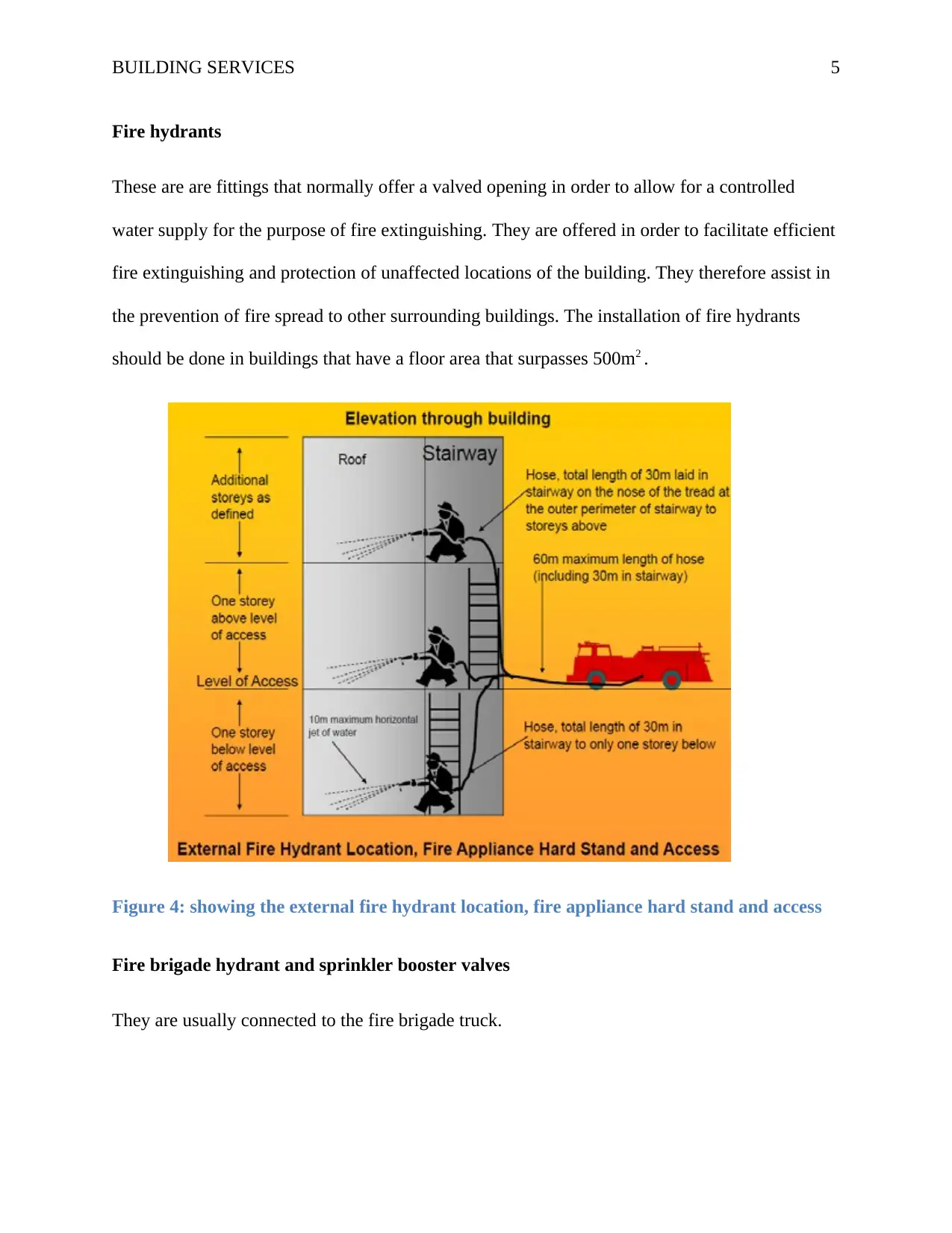
BUILDING SERVICES 5
Fire hydrants
These are are fittings that normally offer a valved opening in order to allow for a controlled
water supply for the purpose of fire extinguishing. They are offered in order to facilitate efficient
fire extinguishing and protection of unaffected locations of the building. They therefore assist in
the prevention of fire spread to other surrounding buildings. The installation of fire hydrants
should be done in buildings that have a floor area that surpasses 500m2 .
Figure 4: showing the external fire hydrant location, fire appliance hard stand and access
Fire brigade hydrant and sprinkler booster valves
They are usually connected to the fire brigade truck.
Fire hydrants
These are are fittings that normally offer a valved opening in order to allow for a controlled
water supply for the purpose of fire extinguishing. They are offered in order to facilitate efficient
fire extinguishing and protection of unaffected locations of the building. They therefore assist in
the prevention of fire spread to other surrounding buildings. The installation of fire hydrants
should be done in buildings that have a floor area that surpasses 500m2 .
Figure 4: showing the external fire hydrant location, fire appliance hard stand and access
Fire brigade hydrant and sprinkler booster valves
They are usually connected to the fire brigade truck.
⊘ This is a preview!⊘
Do you want full access?
Subscribe today to unlock all pages.

Trusted by 1+ million students worldwide

BUILDING SERVICES 6
Figure 5: fire brigade hydrant
Figure 6: sprinkler booster
Fire horse reels (FHR)
FHRs are hose pipes that are connected to the valved supply of water and are then wound around
a reel. They should be provided always so as to serve a wider area of the building compartments.
They are mostly located inside buildings that must be served with an internal fire hydrant. They
can be initially used whilst still setting up other fire extinguishing appliances.
Figure 5: fire brigade hydrant
Figure 6: sprinkler booster
Fire horse reels (FHR)
FHRs are hose pipes that are connected to the valved supply of water and are then wound around
a reel. They should be provided always so as to serve a wider area of the building compartments.
They are mostly located inside buildings that must be served with an internal fire hydrant. They
can be initially used whilst still setting up other fire extinguishing appliances.
Paraphrase This Document
Need a fresh take? Get an instant paraphrase of this document with our AI Paraphraser
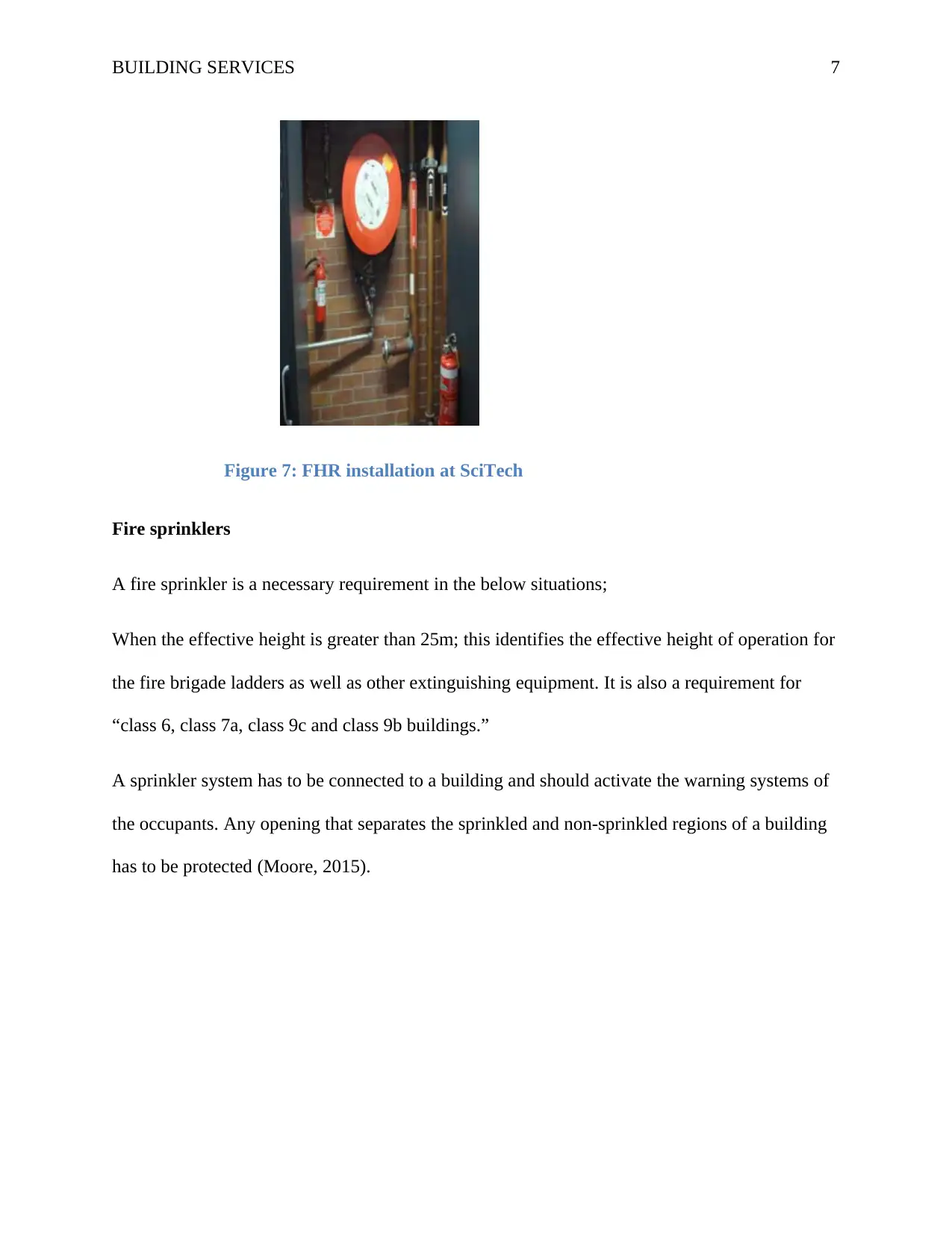
BUILDING SERVICES 7
Figure 7: FHR installation at SciTech
Fire sprinklers
A fire sprinkler is a necessary requirement in the below situations;
When the effective height is greater than 25m; this identifies the effective height of operation for
the fire brigade ladders as well as other extinguishing equipment. It is also a requirement for
“class 6, class 7a, class 9c and class 9b buildings.”
A sprinkler system has to be connected to a building and should activate the warning systems of
the occupants. Any opening that separates the sprinkled and non-sprinkled regions of a building
has to be protected (Moore, 2015).
Figure 7: FHR installation at SciTech
Fire sprinklers
A fire sprinkler is a necessary requirement in the below situations;
When the effective height is greater than 25m; this identifies the effective height of operation for
the fire brigade ladders as well as other extinguishing equipment. It is also a requirement for
“class 6, class 7a, class 9c and class 9b buildings.”
A sprinkler system has to be connected to a building and should activate the warning systems of
the occupants. Any opening that separates the sprinkled and non-sprinkled regions of a building
has to be protected (Moore, 2015).

BUILDING SERVICES 8
Figure 8: Fire sprinkler system
Fire storage tank
The fire storage tank ensures constant flow of water to the fire services that often require large
volume of water and a constant rate of flow.
Figure 8: Fire sprinkler system
Fire storage tank
The fire storage tank ensures constant flow of water to the fire services that often require large
volume of water and a constant rate of flow.
⊘ This is a preview!⊘
Do you want full access?
Subscribe today to unlock all pages.

Trusted by 1+ million students worldwide
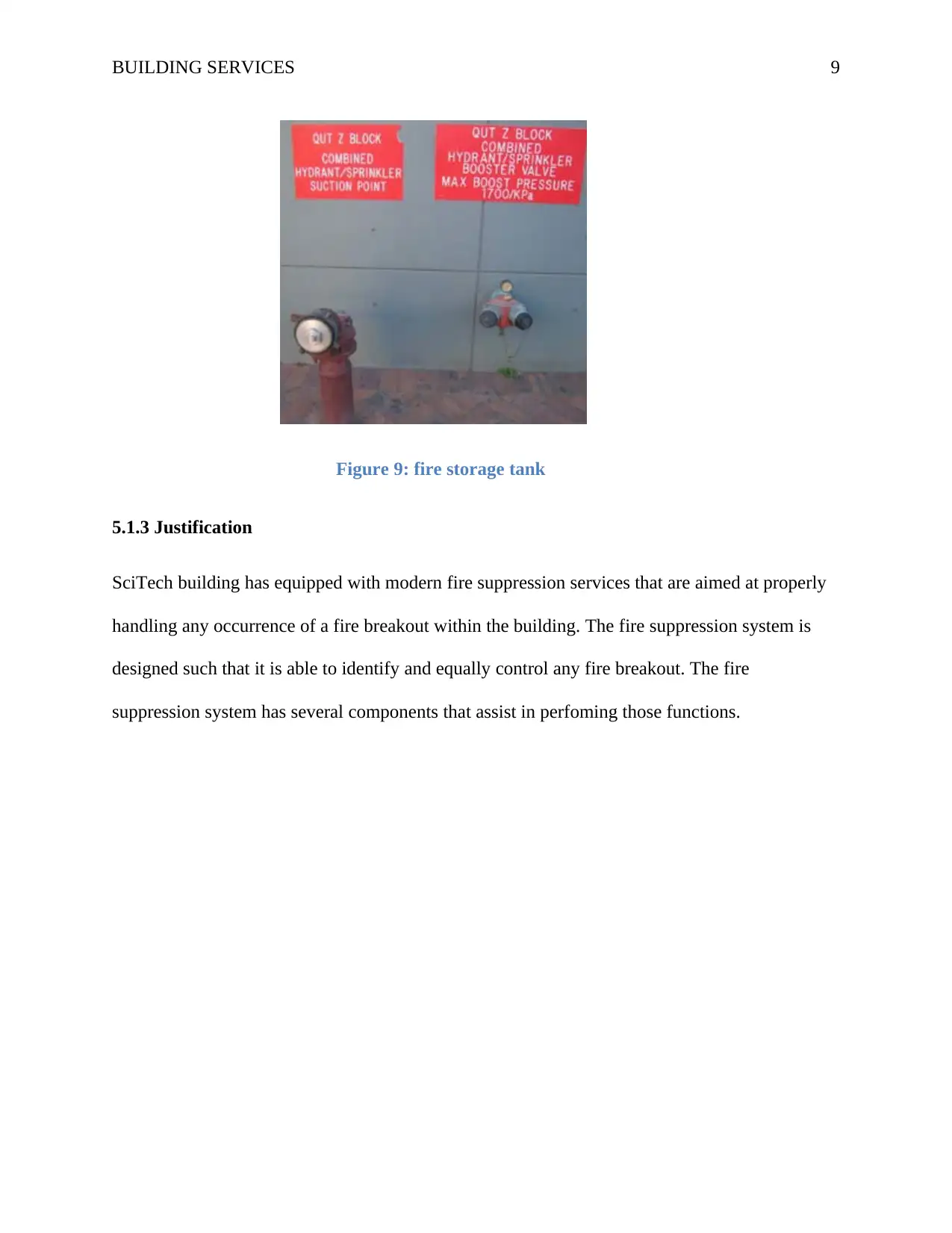
BUILDING SERVICES 9
Figure 9: fire storage tank
5.1.3 Justification
SciTech building has equipped with modern fire suppression services that are aimed at properly
handling any occurrence of a fire breakout within the building. The fire suppression system is
designed such that it is able to identify and equally control any fire breakout. The fire
suppression system has several components that assist in perfoming those functions.
Figure 9: fire storage tank
5.1.3 Justification
SciTech building has equipped with modern fire suppression services that are aimed at properly
handling any occurrence of a fire breakout within the building. The fire suppression system is
designed such that it is able to identify and equally control any fire breakout. The fire
suppression system has several components that assist in perfoming those functions.
Paraphrase This Document
Need a fresh take? Get an instant paraphrase of this document with our AI Paraphraser
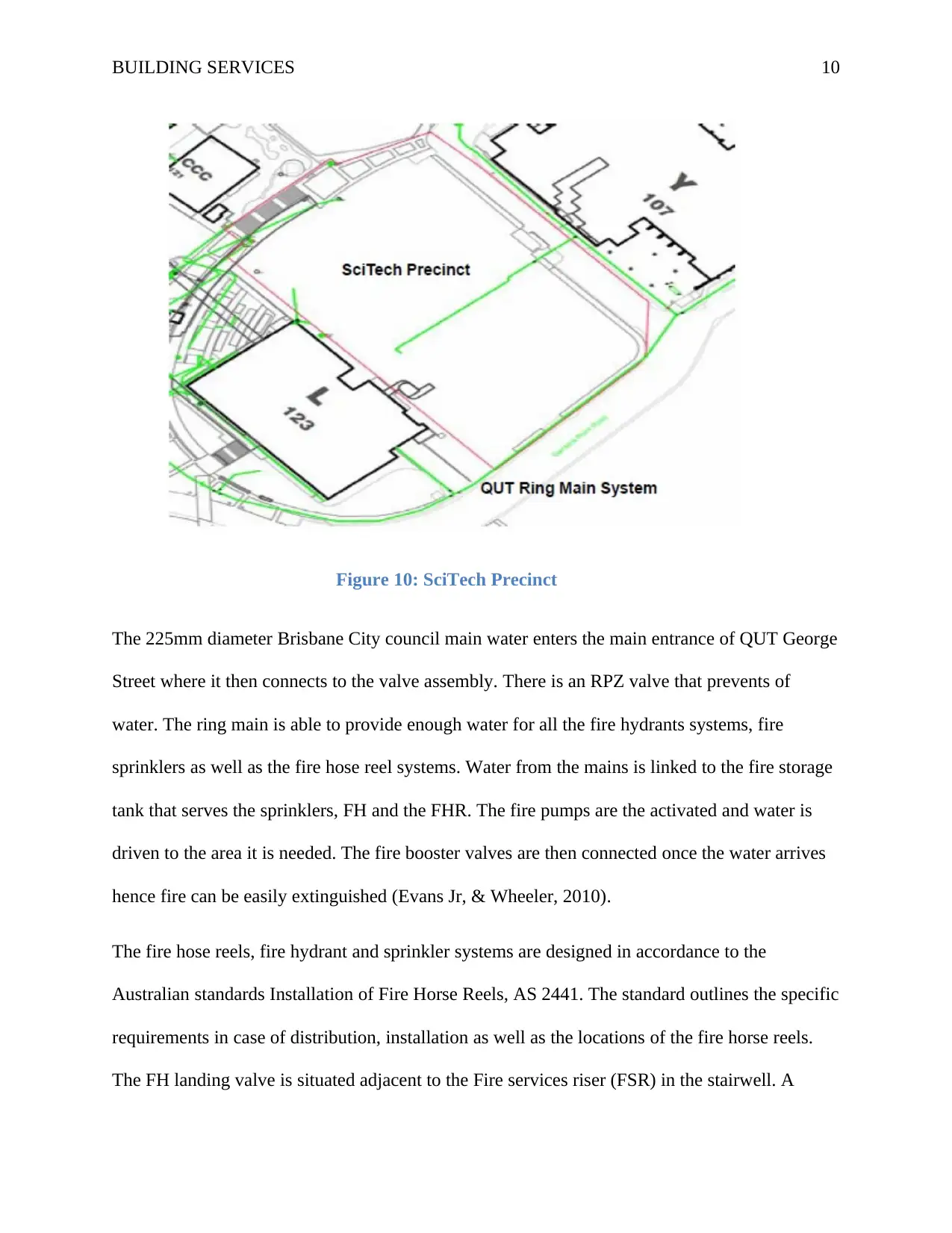
BUILDING SERVICES 10
Figure 10: SciTech Precinct
The 225mm diameter Brisbane City council main water enters the main entrance of QUT George
Street where it then connects to the valve assembly. There is an RPZ valve that prevents of
water. The ring main is able to provide enough water for all the fire hydrants systems, fire
sprinklers as well as the fire hose reel systems. Water from the mains is linked to the fire storage
tank that serves the sprinklers, FH and the FHR. The fire pumps are the activated and water is
driven to the area it is needed. The fire booster valves are then connected once the water arrives
hence fire can be easily extinguished (Evans Jr, & Wheeler, 2010).
The fire hose reels, fire hydrant and sprinkler systems are designed in accordance to the
Australian standards Installation of Fire Horse Reels, AS 2441. The standard outlines the specific
requirements in case of distribution, installation as well as the locations of the fire horse reels.
The FH landing valve is situated adjacent to the Fire services riser (FSR) in the stairwell. A
Figure 10: SciTech Precinct
The 225mm diameter Brisbane City council main water enters the main entrance of QUT George
Street where it then connects to the valve assembly. There is an RPZ valve that prevents of
water. The ring main is able to provide enough water for all the fire hydrants systems, fire
sprinklers as well as the fire hose reel systems. Water from the mains is linked to the fire storage
tank that serves the sprinklers, FH and the FHR. The fire pumps are the activated and water is
driven to the area it is needed. The fire booster valves are then connected once the water arrives
hence fire can be easily extinguished (Evans Jr, & Wheeler, 2010).
The fire hose reels, fire hydrant and sprinkler systems are designed in accordance to the
Australian standards Installation of Fire Horse Reels, AS 2441. The standard outlines the specific
requirements in case of distribution, installation as well as the locations of the fire horse reels.
The FH landing valve is situated adjacent to the Fire services riser (FSR) in the stairwell. A
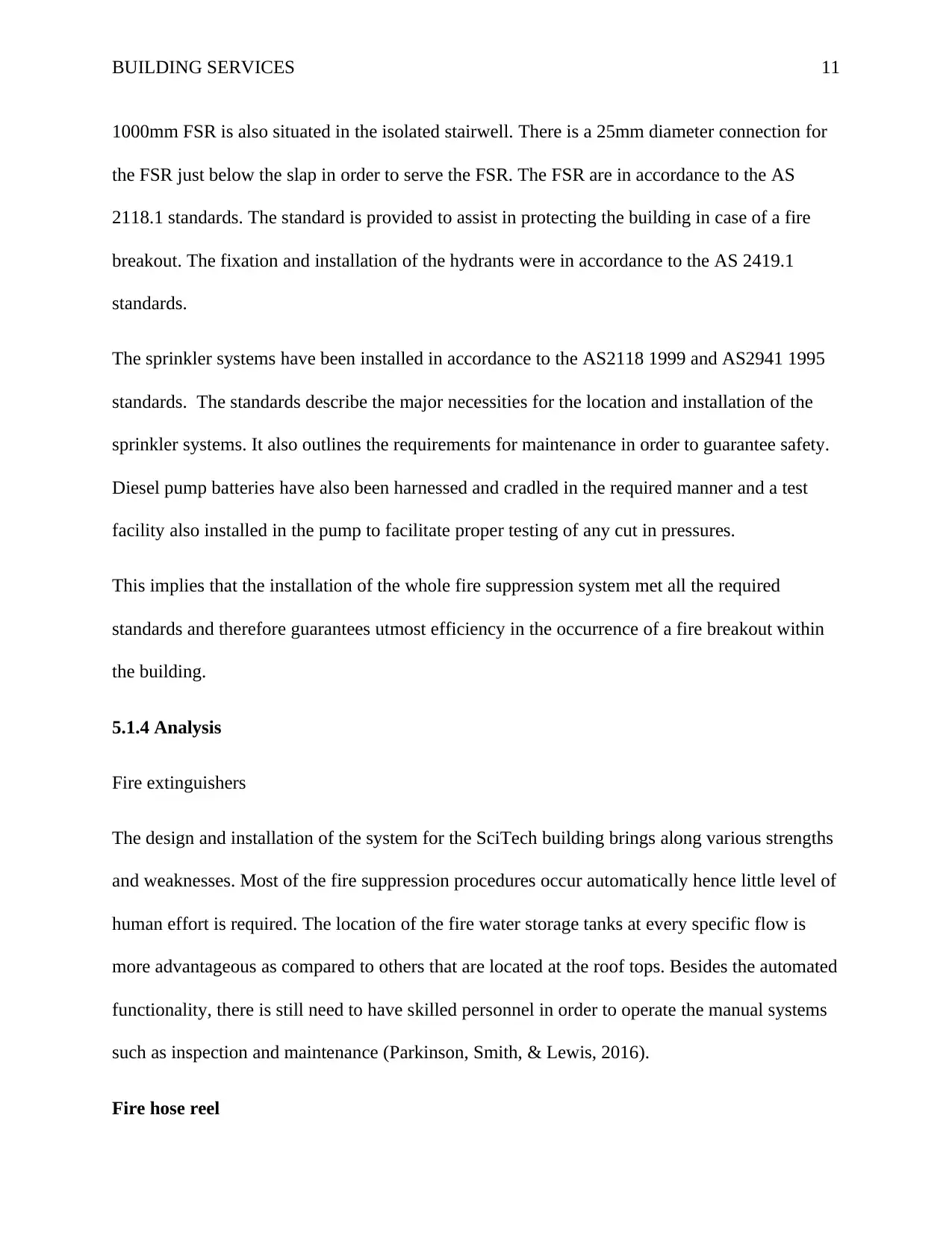
BUILDING SERVICES 11
1000mm FSR is also situated in the isolated stairwell. There is a 25mm diameter connection for
the FSR just below the slap in order to serve the FSR. The FSR are in accordance to the AS
2118.1 standards. The standard is provided to assist in protecting the building in case of a fire
breakout. The fixation and installation of the hydrants were in accordance to the AS 2419.1
standards.
The sprinkler systems have been installed in accordance to the AS2118 1999 and AS2941 1995
standards. The standards describe the major necessities for the location and installation of the
sprinkler systems. It also outlines the requirements for maintenance in order to guarantee safety.
Diesel pump batteries have also been harnessed and cradled in the required manner and a test
facility also installed in the pump to facilitate proper testing of any cut in pressures.
This implies that the installation of the whole fire suppression system met all the required
standards and therefore guarantees utmost efficiency in the occurrence of a fire breakout within
the building.
5.1.4 Analysis
Fire extinguishers
The design and installation of the system for the SciTech building brings along various strengths
and weaknesses. Most of the fire suppression procedures occur automatically hence little level of
human effort is required. The location of the fire water storage tanks at every specific flow is
more advantageous as compared to others that are located at the roof tops. Besides the automated
functionality, there is still need to have skilled personnel in order to operate the manual systems
such as inspection and maintenance (Parkinson, Smith, & Lewis, 2016).
Fire hose reel
1000mm FSR is also situated in the isolated stairwell. There is a 25mm diameter connection for
the FSR just below the slap in order to serve the FSR. The FSR are in accordance to the AS
2118.1 standards. The standard is provided to assist in protecting the building in case of a fire
breakout. The fixation and installation of the hydrants were in accordance to the AS 2419.1
standards.
The sprinkler systems have been installed in accordance to the AS2118 1999 and AS2941 1995
standards. The standards describe the major necessities for the location and installation of the
sprinkler systems. It also outlines the requirements for maintenance in order to guarantee safety.
Diesel pump batteries have also been harnessed and cradled in the required manner and a test
facility also installed in the pump to facilitate proper testing of any cut in pressures.
This implies that the installation of the whole fire suppression system met all the required
standards and therefore guarantees utmost efficiency in the occurrence of a fire breakout within
the building.
5.1.4 Analysis
Fire extinguishers
The design and installation of the system for the SciTech building brings along various strengths
and weaknesses. Most of the fire suppression procedures occur automatically hence little level of
human effort is required. The location of the fire water storage tanks at every specific flow is
more advantageous as compared to others that are located at the roof tops. Besides the automated
functionality, there is still need to have skilled personnel in order to operate the manual systems
such as inspection and maintenance (Parkinson, Smith, & Lewis, 2016).
Fire hose reel
⊘ This is a preview!⊘
Do you want full access?
Subscribe today to unlock all pages.

Trusted by 1+ million students worldwide
1 out of 28
Your All-in-One AI-Powered Toolkit for Academic Success.
+13062052269
info@desklib.com
Available 24*7 on WhatsApp / Email
![[object Object]](/_next/static/media/star-bottom.7253800d.svg)
Unlock your academic potential
Copyright © 2020–2025 A2Z Services. All Rights Reserved. Developed and managed by ZUCOL.


